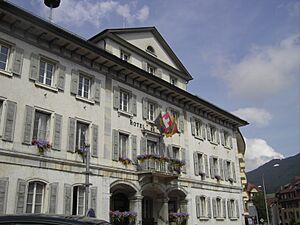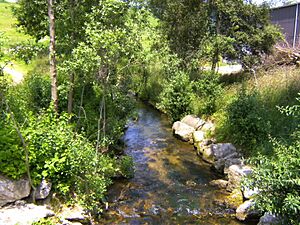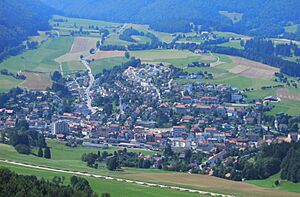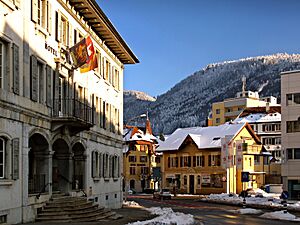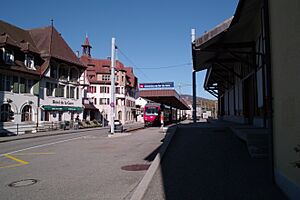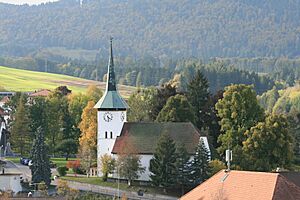Tavannes facts for kids
Quick facts for kids
Tavannes
|
||
|---|---|---|
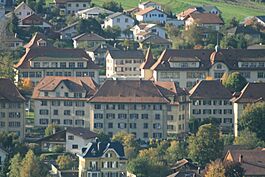
Tavannes town
|
||
|
||
| Country | Switzerland | |
| Canton | Bern | |
| District | Jura bernois | |
| Area | ||
| • Total | 14.78 km2 (5.71 sq mi) | |
| Elevation | 754 m (2,474 ft) | |
| Population
(Dec 2020 )
|
||
| • Total | 3,485 | |
| • Density | 235.79/km2 (610.70/sq mi) | |
| Postal code |
2710
|
|
| Localities | La Tanne | |
| Surrounded by | Saicourt, Reconvilier, La Heutte, Sonceboz-Sombeval, Corgémont, Tramelan, Mont-Tramelan | |
Tavannes is a town in Switzerland. It is located in the Jura mountains, in the French-speaking part of the Bern canton. It is part of the Jura bernois district.
Contents
History of Tavannes
Long ago, people traveled through the area around Tavannes. They used a natural tunnel through the Jura mountains. The Romans improved this road between 161 and 169 AD. A Roman leader even left a message carved into the cliff at Pierre-Pertuis.
Early mills were built along the Birse river. They used the river's power to operate. Tavannes was one of the first places settled in the area. Its name comes from old Germanic words meaning "badger pasture."
In the 4th century, the Burgundians moved into the area. In 630, a monastery was built at Moutier-Grandval. Tavannes became part of its lands.
The name Tavannes (or Theisvenna) was first written down in 866. In 999, King Rudolph III of Burgundy gave the Moutier-Grandval monastery and its lands to the Prince-Bishop of Basel. After Rudolph died, the area became part of the Holy Roman Empire for 760 years.
The Reformation and French Influence
In 1530, Guillaume Farel brought the Protestant Reformation to Tavannes. Many people accepted the new faith. The village church, built in 1385, became a Reformed church. It was the only church in Tavannes until the Catholic Church of Christ-Roi was built in 1930.
After the French Revolution, the French army came to the area in 1792. They recruited local soldiers. One of them was Théophile Voirol. He quickly became a general and later a French noble. He even became Governor of Algeria.
After France won a war in 1797, Tavannes became part of a French region called Mont-Terrible. Later, it became part of another French region, Haut-Rhin. After Napoleon was defeated, Tavannes joined the Canton of Bern in 1815. The town government was set up after the Bishopric of Basel ended in 1797.
Modern Development
Tavannes got a railway connection in 1874. By the 1890s, it had several large factories. The Tavannes Watch Co. started in 1895. This made the town a major center for watchmaking. Many Swiss chalet and Art Nouveau style houses were built between 1900 and 1930. This was to house the growing population.
The Royal Cinema opened in 1918. This made Tavannes a cultural hub for the region. The population went down in 1966 when the Tavannes Watch factory closed. It dropped again in 1986 when another big factory shut down. The population slowly started to grow again when the A16 motorway was built.
Geography of Tavannes
Tavannes covers an area of about 14.65 square kilometers. As of 2012, nearly half of the land (48.2%) is used for farming. About 41.1% is covered by forests. The rest of the land is used for buildings, roads, or rivers.
Most of the forested land is dense forest. For farming, land is used for crops, pastures, and alpine pastures. All the water in Tavannes is flowing water, like rivers.
The town is located near where the Birs river starts, in the Birs valley. In 2010, Tavannes joined the new Jura bernois administrative district.
Tavannes Coat of Arms
The coat of arms for Tavannes shows a golden rooster standing on three green hills. The background is blue.
People of Tavannes
Tavannes has a population of about 3,525 people (as of December 2011). About 18.7% of the people living here are foreign nationals. Over the last ten years, the population has grown slightly.
Most people in Tavannes (about 84%) speak French as their main language. German is the second most common (6%), and Italian is third (3.6%).
In 2008, the population was almost equally split between males (49.5%) and females (50.5%). Many people living in Tavannes were born there (30.9%). Others were born in the same canton (31.7%) or elsewhere in Switzerland (13.7%). About 20% were born outside Switzerland.
In 2011, children and teenagers (0–19 years old) made up 22.8% of the population. Adults (20–64 years old) made up 60.6%, and seniors (over 64 years old) made up 16.6%.
Most people in Tavannes are married (1,631 people in 2000). There are also many single people (1,355).
The chart below shows how the population of Tavannes has changed over time:

Important Heritage Sites
The Church of Christ-Roi and the Pierre Pertuis are very important historical sites in Switzerland. The entire village of Tavannes is also recognized as a heritage site.
Church of Christ-Roi
The Church of Christ-Roi was built between 1928 and 1930. It is a simple church with three aisles. Many artists from the St. Luke Society decorated the inside. For example, the mosaic of the resurrection above the main entrance was made by Gino Severini. The main altar and pulpit mosaics were done by Emilio-Maria Beretta. The beautiful stained glass windows were created by Alexandre Cingria.
Pierre Pertuis Passage
The Pierre Pertuis is a tunnel carved into the mountains. It was made during the Roman era. This tunnel marked the border between two ancient groups of people, the Raurici and the Helvetii. An inscription from the 3rd century is still visible on the north side of the tunnel.
Economy and Work
In 2011, Tavannes had a low unemployment rate of 2.72%. In 2008, there were 1,212 people working in the town.
- About 57 people worked in farming and related businesses.
- About 476 people worked in factories and construction.
- About 679 people worked in services, like shops, offices, and healthcare.
Many people who live in Tavannes also work there. In 2000, 678 workers (about 50.5%) lived and worked in the town. About 13.6% of workers used public transportation to get to work, and 60.4% used a private car.
In 2011, the average tax rate for a married resident with two children was 13.1%. For an unmarried resident, it was 19.2%.
Religion in Tavannes
According to the 2000 census:
- About 40.6% of the people belonged to the Swiss Reformed Church.
- About 33.3% were Roman Catholic.
- Smaller groups included Orthodox Christians, other Christians, and Muslims.
- About 9.46% of the population did not belong to any church.
Education in Tavannes
In Tavannes, about 49.6% of people have finished upper secondary education. About 11.9% have completed higher education, like university.
The Bern school system has one year of optional kindergarten. Then there are six years of primary school. After that, students go to three years of lower secondary school. Here, students are grouped by their abilities. After lower secondary, students can continue their education or start an apprenticeship.
During the 2011-12 school year, 455 students attended schools in Tavannes.
- There were 69 kindergarten students.
- There were 241 primary school students.
- There were 111 lower secondary students.
Some students were not Swiss citizens, and some spoke a different language at home than in the classroom.
Tavannes has a regional library called Bibliothèque régionale de Tavannes. In 2008, it had over 13,301 books and other media. It loaned out 38,099 items that year.
Transportation
Tavannes has a railway station called Tavannes. Trains regularly travel to Biel/Bienne, Moutier, and Le Noirmont.
Attractions
- The Big Boss' Festival, a Christian music festival, is held here every year.
Images for kids
See also
 In Spanish: Tavannes para niños
In Spanish: Tavannes para niños





